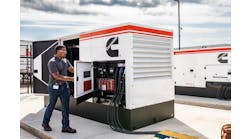Energy-as-a-Service Offers Hope to Airports, Railways and Seaports through Technological and Financial Innovation
Karen Morgan, president and CEO of Dynamic Energy Networks, explores how energy-as-a-service can impact railways, airports and seaports to increase resiliency for America’s transportation.
Railways, airports and seaports connect people and goods in essential ways, both locally and globally. Unfortunately, this connection becomes vulnerable during natural disasters because it relies on a centralized electric grid. So, it’s essential to explore approaches to ensure power resilience and upgrade energy infrastructure at critical transportation sites.
Recovering from the effects of natural disasters on the electrical systems of railways, airports and seaports can be slow and expensive. This reality, along with an industry-wide move to more distributed power generation, has fueled interest in microgrids — energy systems that can island from the larger power grid in an emergency.
An Energy-as-a-Service (EaaS) approach can make the transformation to microgrids feasible, so that all stakeholders quickly benefit.
Supporting our ports
From its earliest days, America’s seaports have been a driving economic force. In 2014, the analyst firm Martin Associates determined that coastal ports account for 26 percent of the nation’s $17.4 trillion economy.
Aging infrastructure is at the forefront of concerns for port operators and the cities that depend on their economic stimulation. Several ports are taking steps to develop microgrids to reduce the risk that the port’s power will be lost due to a single point of failure at the utility level — whether caused by storms, flooding or any other outside event.
The Port of San Diego is planning a microgrid that will have 700 kW of solar and 700 kW of energy storage to cut the port’s energy costs and test how well the microgrid can island from the grid and for how long, according to a July 2018 Microgrid Knowledge article. Other ports have taken a modular approach to microgrids, providing incoming freighters and cruise ships with connectivity to a local grid that provides electricity from a cleaner (and quieter) source than the ships’ own fossil-fuel burning generators. Microgrids can mitigate the climate impact that ports have by increasing efficiencies and using cleaner forms of energy.
Improving the efficiency and infrastructure of U.S. ports is essential for several reasons. Ports are often co-located with airports, railway stations, and other critical facilities. For example, having a microgrid at the Port of San Diego during emergencies will also benefit the nearby San Diego International Airport and the U.S. Department of Defense, which is based at the airport.
Ports perform a critical economic role in the U.S. as commercial facilities and sources of employment. Therefore, having a microgrid will offer economic, environmental and social benefits.
Advances for airports
Though proportionally not as large a contributor to the U.S. economy as ports, airports nevertheless are indispensable to the movement of people and goods. The Economic Impact of Civil Aviation on the U.S. Economy reported in November that: “At the national level in 2014, civil aviation generated $1.6 trillion in economic activity, supported 10.6 million jobs with $446.8 billion in earnings. Civil aviation accounted for 5.1 percent of U.S. gross domestic product.”
A single airport outage can cost millions for the airlines and for the airport. Travelers become wary of making connections and booking flights through airports with outage issues.
Since the transportation sector is also a significant contributor to pollution worldwide, compliance with federal and state clean energy mandates also drives the move to microgrids and clean electrification of airports and their vehicles, both landside and airside. Airport land represents a large untapped resource for airports. Writing in IEEE Spectrum magazine, David Wagman cites a July 2014 report by the Energy Department’s National Renewable Energy Laboratory (NREL) which “estimates that more than 816,000 acres of vacant land within nearly 3,000 airports across the United States could support more than 116,000 megawatts of fixed-axis solar photovoltaic generating capacity, the equivalent output of around 100 coal-fired power plants.” The list of airports that have adopted these solutions is growing every year; now over 50 US airports have installed solar PV.
While solar installations improve the energy infrastructure of airports, they are only the first step. Installing a comprehensive microgrid/vehicle electrification transformation is the next logical step. Although the terms solar and solar microgrid are often used interchangeably, they are not the same. Both generate power with solar, but a solar microgrid functions as an island from the grid — it disconnects from the grid when it senses a disruption coming and relies on its own solar and other distributed energy. The move to fully microgrid is growing at airports large and small.
New ways for railways
Commuters and freight depend on rail daily. Trains cannot afford to shut down due to regional outages. Major U.S. railroads support 1.5 million jobs, nearly $274 billion in annual economic activity, $88 billion in wages and nearly $33 billion in tax revenues according to a Towson University study cited in InfrastructureUSA.
Interest in rail microgrids is growing, especially in the mid-Atlantic region (affected by Superstorm Sandy). In 2016, Amtrak proposed a microgrid to provide critical transportation services to uphold resilience for two major hubs — its Sunnyside Yard in Queens and Penn Station in Manhattan. The microgrid would include a total of 17.2 MW of energy generation and 4 MWh of storage. New Jersey has publicized its interest in microgrids to advance resilience with its NJ TransitGrid program announced in 2013.
Transportation infrastructure needs EaaS
Often seaports, airports and railway stations intend to install a clean and resilient energy solution, but they lack the capital to take on the challenge. The EaaS offers a proven way to make the transformation.
By avoiding the need to make a large upfront expenditure for the microgrid, EaaS removes one of the biggest obstacles in an industry plagued with aging assets and a lack of available funding to upgrade. The city or transportation authority pays only for the power on an operational basis, much as they pay their electric utility — with the enhanced benefits resilience, sustainability and of locking in predictable energy costs years (or even decades) ahead.
Toward a resilient future
Railways, airports and seaports are responsible for some of the most critical functions of society in terms of people, commercial goods and economic viability. Making sure that they have reliable power is crucial to a sustainable future. An EaaS approach allows transportation hubs to pay for the energy they need, all delivered via a clean, efficient, more resilient advanced microgrid solution.
Karen Morgan is president and CEO of Dynamic Energy Networks.







